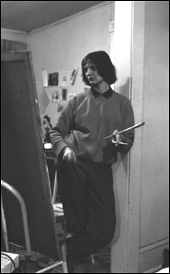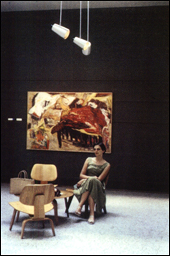
ca 1959. Photo Allen Downs.
M.F.A. programme
I
The M.F.A. programme at the University of Minnesota, which she had had trouble getting into, had been enormously important for her.
She didn’t get along at all with the Art Department’s best-known painter, the formalist-abstractionist Cameron Booth. On one occasion, she said, he physically ejected her from the classroom—took her by the shoulders and pushed her out of the door. But Malcolm Myers was a very fine print-maker and they liked and respected each other, Phillip Morton was a technically accomplished sculptor, and the painter Bernard Arnest, her studio advisor, was generously supportive.
The photography department was excellent—Alan Downs in photography and documentary movie-making, Jerry Liebling carrying on the Paul Strand tradition of plain photography. The potter Warren Mackenzie had studied under Leach, and I still have several lovely pieces by him. I don’t think C. made any pots herself, at least none that she kept. But she did a few fine pieces of jewelry, probably under Morton.
II
The biggest stimulation in painting came for her when the Abstract Expressionist artist Jack Tworkow spent a term there. She was his course assistant, I believe, and they got along very well together. Apparently he talked art, lived art, dramatized the making of art, and took students seriously. C.’s brushwork became looser, particularly in the large painting The Executive, which was bought by the Walker, and Moonlight Bathers.
The two of them shared an admiration for Soutine. Soutine… De Kooning… Tworkow. She was painting thin as well as thick in those years, and continued to do so, but she fought with the canvas at times. In the mid-Sixties the paint grew thicker and thicker on the painting Mistral and still wouldn’t come out right for her, partly perhaps because the forms were so amorphous that it was hard to tell when it was in fact “right.” She increasingly wanted every area in a canvas to be charged with meaning.
III
But it wasn’t just the studio work that mattered, there was also the intellectual stimulation. There were stiff requirements. She took European and American Prints from Hilton Thomas and American art from Don Torbert. She assisted in Lorenz Eitner’s brilliant survey class, an education in itself. These are names that I remember. There may have been others.
She also had to write a thesis, and wrote a substantial one, a hundred-and-twenty pages or so, on figurative painting in Rouault, Chagal, Soutine, and De Kooning.
And she had to do classes outside art. She took Aesthetics for three terms in the Philosophy Department from the distinguished aesthetician John Hospers. She took a class in critical theory from the well-known poet-critic Allen Tate, of whom she later did the splendid bronze portrait bust and accompanying print and drawings that the Smithsonian bought after Tate died. The bust was cast in the Department’s foundry by the African-American sculptor Richard Randall. At least two other African-American artists were active and visible in the city.
IV
The morale of the M.F.A. students, so far as I could judge, was excellent. There were some genuinely talented ones there. The very intelligent Carol Lind Geary whose work on Zen drawings for her thesis carried over into her own art, was closest to C., I think. (I suspect that C. may have felt that Carol was more innately gifted than herself.) The sculptor Dale Eldred was there, working at a high pitch of energy, also Freddy Munoz and Richard Randall.
And there were other good ones—her friend Bill Bartsch, Bob Berg in prints, and ones whose names I cannot now remember or may never have learned. At a party in the early stages of our courtship, Lynn Myers volunteered to me that C. was “the most intelligent of us.” John Beauchamp, who had become a kind of paradigm of purity and reclusiveness, had been a student in the programme and was living and painting not far from campus.
Minneapolis also offered young artists the benefits of two major museums, the Walker and the Art Institute, and a number of juried shows that they had a reasonable chance of getting into. Minnesota was generous-spirited with respect to the arts.
V
When we came up here to Halifax in 1961, she must have felt for awhile where art-education and art-nourishment was concerned, as though she had fallen off the edge of the known world. Fortunately Europe in those days was cheaper of access than it is now, and the following summer we visited European museums and started discovering Van Gogh’s Provence together.

Sunflower Hedge, 1960, oil






